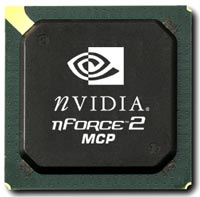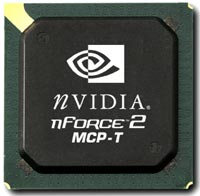Two new MCPs
Although the new IGP and support for new memory speeds are both compelling features of nForce2, NVIDIA’s emphasis remains strong on their Media & Communications Processors (MCP). The MCP acronym, as you’ll remember from the original nForce, is NVIDIA’s version of the classic South Bridge. The MCP is connected to the IGP/SPP via a Hyper Transport link, which makes these MCPs that we’re going to talk about perfect candidates for the forthcoming Hammer/K8 version of the nForce2 chipset. For more information on Hyper Transport’s role in nForce2, take a look at our original nForce preview.
The nForce2 chipset debuts with two MCP offerings: MCP and MCP-T. The basic MCP is a bare MCP that is pin-compatible with the original MCP that was introduced with nForce. This MCP supports USB 2.0, ATA/133 and it has NVIDIA’s own Ethernet MAC. The basic MCP does not have NVIDIA’s Audio Processing Unit (APU) and just basic AC’97 audio support without an integrated DSP. This is the cost effective MCP that can be used on entry-level motherboard designs.

The MCP-T is the more interesting of the two as it builds upon the MCP features by adding IEEE-1394a (Firewire) support, NVIDIA’s APU (unchanged from the original nForce) and a second Ethernet MAC. This second MAC is provided by 3Com, and the combination of the two solutions allows the MCP-T to have “router on a chip” functionality. With two integrated Ethernet MACs, all that’s necessary to enable what NVIDIA calls their DualNet architecture are two relatively cheap Ethernet PHYs to bring two 10/100 Ethernet ports to a nForce2 motherboard. The most obvious configuration is where a broadband Internet connection comes into one of the Ethernet ports with the remaining port on your nForce2 system going out to a switch to provide Internet access to all of the PCs on your network. With Intel’s vision of powerful home PCs acting as content servers to the rest of the house, NVIDIA’s “router on a chip” idea seems to be validated.

Since both of these MCPs interface to the IGP/SPP using Hyper Transport, motherboard manufacturers can reduce costs by using the old nForce 420/415/220 IGPs with the newer MCPs. Also keep in mind that the new MCPs don’t introduce a new APU, so audio quality and DSP performance remain unchanged from the original nForce chipset/MCP.










7 Comments
View All Comments
juanforce - Thursday, October 7, 2021 - link
The nForce2 chipset was released by Nvidia in July 2002 as a refresh to the original nForce product offering. The nForce2 chipset was a platform for motherboards supporting AMD's Socket A CPUs along with DDR SDRAM.